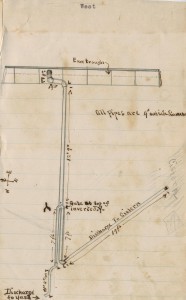This next installment in our series on lighthouse technology focuses on the cistern the lighthouse keepers used to collect rain and provide water for cooking, cleaning, and drinking.
Click the link below to read previous post in the series:
Keeping a lighthouse operational required technology we rarely use today: oil lanterns, clockwork mechanisms, and more. Living at a lighthouse, often isolated from towns and lacking indoor plumbing or electricity, lighthouse keepers used methods we rarely use today just to provide clean water. Keepers often took advantage of rainfall by utilizing a cistern, a tank designed to collect rainwater and store it for use in cooking, bathing, and drinking.
The Keepers’ House at the St. Augustine Light Station features a cistern in the basement. The brick cistern tanks are built into the structure of the Keepers’ House supporting the residence as the water they held supported the residents. Rainwater flowed from the roof, through a series of gutters and pipes, and into the large brick tanks. Keepers and their families could then pump the water back out of the cistern when needed.
Although the rainwater was pure, by the time the water traveled from the roof to the cistern it became contaminated. As the 1881 Instructions to Light-Keepers points out  “water contaminated with chloride of lead from salt spray resting on the leads of light-houses, &c., whence rain water is collected, does not lose its poisonous qualities either by boiling or by exposure to air. To purify this water, and render it perfectly fit for all culinary and domestic purposes, it will only be necessary to put some powdered chalk or whiting into each cistern in which such rain water is collected, and to stir it up well, occasionally, after rain has fallen.”
“water contaminated with chloride of lead from salt spray resting on the leads of light-houses, &c., whence rain water is collected, does not lose its poisonous qualities either by boiling or by exposure to air. To purify this water, and render it perfectly fit for all culinary and domestic purposes, it will only be necessary to put some powdered chalk or whiting into each cistern in which such rain water is collected, and to stir it up well, occasionally, after rain has fallen.”
The delivery system of pipes from the roof is no longer present, but we do have some sketches drawn by Head Keeper Clarence Malloy showing their design. The sketches are from 1927 and appear to be supplemental information for a request to replace the pipes, which were rusting and some of the wooden gutter, which was rotten.

Two windows look into the cistern, with the remains of a small pipe between them
Today, the pipes are gone and only the holes in the brick remain as testament to their presence. Several smaller holes appear to be pipes draining from the roof into the cistern. There is also a larger overflow pipe leaving one of the cistern tanks that would have carried excess water out of the cistern to the front of the Keepers’ House. Lighthouse archaeologists found this pipe, encased in bricks, running diagonally from the front of the Keepers’ House during a construction project a few years ago. The cistern no longer gathers water, but the evidence of it remains.
The Keepers’ House cistern is in the basement of the Keepers’ House, which we are currently transforming into our new Wrecked exhibit, opening in May 2016. Read more here.
Paul Zielinski is Director of Interpretation for the St. Augustine Lighthouse & Maritime Museum. He received his master’s degree in Public History from the University of West Florida and joined the lighthouse family in 2011.


